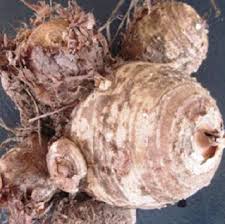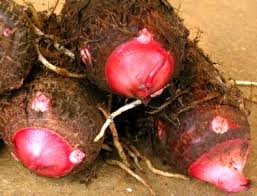Cocoyam cormels, also known as cocoyam corms or tubers, refer to the underground swollen stems or root-like structures of the cocoyam plant (Colocasia esculenta). Cocoyam is a tropical root vegetable that is commonly grown and consumed in many parts of the world, particularly in Africa, Asia, and the Pacific islands.
The cormels of cocoyam are a staple in various cuisines and can be prepared in a variety of ways. They are often used to make soups, stews, porridges, or can be fried, boiled, or roasted. Cocoyam cormels are known for their starchy texture and mild, nutty flavor.
When preparing cocoyam cormels, they are typically peeled, cleaned, and then cooked based on the desired recipe. They can be used in both savory and sweet dishes and are a good source of carbohydrates, dietary fiber, vitamins, and minerals.
The Economic Importance and Uses of Cocoyam Cormels

Cocoyam cormels, also known as taro or eddoe corms, are a significant staple food in many parts of the world, particularly in Africa, Asia, and the Pacific. These cormels have various economic and practical uses, including agricultural, culinary, industrial, and nutritional aspects.
Here are some of the economic importance and uses of cocoyam cormels:
1. Staple Food: Cocoyam cormels serve as a staple food for millions of people worldwide, providing a source of carbohydrates, dietary fiber, and essential nutrients. They can be boiled, steamed, roasted, or fried and used in a variety of dishes.
2. Income Generation: Cultivation and sale of cocoyam cormels provide a source of income for farmers and traders. The demand for cocoyam cormels in local and international markets can create economic opportunities for individuals and communities.
3. Export and Trade: Cocoyam cormels are often exported to other countries, contributing to international trade and foreign exchange earnings for producing regions. They are in demand in various countries with diaspora communities familiar with cocoyam-based cuisines.
4. Industrial Uses: Cocoyam cormels can be processed into various products for industrial use. For example, they can be used in the production of starch, flour, and other food additives.
5. Food Processing: Processed cocoyam products, such as cocoyam flour or cocoyam paste, are used in the food industry to create a range of products like bread, cakes, snacks, and baby food. These products expand the versatility and marketability of cocoyam cormels.
6. Animal Feed: Cocoyam cormels can be used as animal feed, providing nutrition to livestock and poultry. This utilization helps support the livestock and poultry industry, contributing to overall agricultural productivity.
7. Traditional Medicine: In traditional medicine, cocoyam cormels are sometimes used for their purported medicinal properties. They may be used to treat various ailments or conditions, although scientific validation is essential for confirming these claims.
8. Soil Improvement: Cocoyam plants, including the cormels, are beneficial in improving soil structure and fertility. They can be used in crop rotation systems to enhance soil health, which supports sustainable agricultural practices.
9. Culinary Diversity: Cocoyam cormels offer culinary diversity and can be used to create a wide range of dishes, enhancing the variety of meals available to people. They can be the main ingredient in stews, soups, stir-fries, and more.
Read Also: Cocoyam Roots: Economic Importance, Uses, and By-Products
10. Food Security: The cultivation and consumption of cocoyam cormels contribute to food security by providing a reliable source of nutrition and sustenance, particularly in regions where they are a staple food.
The Products and By-products That Can Be Derived From Cocoyam Cormels
Cocoyam (Colocasia esculenta) cormels, also known as taro or eddoe, are versatile root vegetables that can be processed to produce a variety of products and by-products.
Here’s a list and explanation of some of the products and by-products that can be derived from cocoyam cormels:
1. Cocoyam Flour: Processed by drying and grinding cocoyam cormels into a fine powder. It can be used in baking, cooking, or as a thickener for soups and sauces.
2. Cocoyam Chips: Slices of cocoyam cormels can be fried or baked to create crispy chips. These are a popular snack in many regions.
3. Cocoyam Starch: Extracted from cocoyam cormels and used as a thickening agent in food products, particularly in the food industry.
4. Cocoyam Fufu: A staple food in many African countries, cocoyam fufu is made by boiling and mashing cocoyam cormels. It is typically served with soup or sauce.
5. Cocoyam Puree: Boiled and mashed cocoyam cormels can be processed into a smooth puree, which can be used as a base for various dishes.
6. Cocoyam Chips (Animal Feed): Leftover or lower-grade cocoyam chips that are not suitable for human consumption can be used as animal feed.
7. Cocoyam Peel Powder (Animal Feed or Organic Fertilizer): The peels of cocoyam cormels can be dried and ground into a powder. This powder can be used as animal feed or as organic fertilizer for crops.
8. Cocoyam Leaves: While not a product of the cormels specifically, cocoyam leaves are edible and nutritious. They can be used in various dishes such as stews and soups.
9. Cocoyam Snacks (Processed Products): Cocoyam cormels can be processed into a variety of snacks, including crisps, chips, and puffs, offering a range of textures and flavors.
10. Cocoyam Jam or Spread: Cooked and mashed cocoyam cormels can be turned into a jam or spread, often sweetened and flavored with additional ingredients.
11. Cocoyam Powder (Gluten-Free Flour Substitute): Cocoyam powder can be used as a gluten-free flour substitute in baking, making it suitable for individuals with gluten intolerance.
12. Cocoyam Wine (Traditional Fermented Product): In some cultures, cocoyam cormels are used to produce traditional alcoholic beverages like cocoyam wine through fermentation processes.
13. Cocoyam Vinegar: Fermented cocoyam cormels can be processed to produce vinegar, which can be used for culinary purposes.
In conclusion, cocoyam cormels play a crucial role in providing sustenance, generating income, supporting industries, enhancing agricultural practices, and contributing to culinary diversity and food security. Additionally, their versatility allows for various applications across different sectors, showcasing their economic and practical importance.

